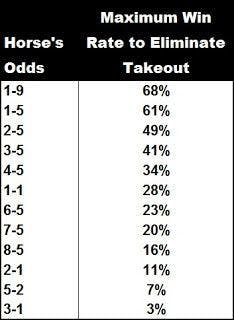How to Spot Losing Favorites

What this table shows is the maximum success (win) rate horses at the specified odds can achieve in order to wipe out both the takeoutand breakage(based on a 122 percent pool).
Anything below the listed percentage means that a dutch of all the other runners would result in profits, while anything above the listed percentage entails an incrementally greater house advantage.
On Monday, the son of Ghostzapper set the pace for half a mile and faded steadily thereafter; he finished dead last, beaten by 31 lengths.
Anything below the listed percentage means that a dutch of all the other runners would result in profits, while anything above the listed percentage entails an incrementally greater house advantage.
For example, if one were to discard all 6-5 favorites from win consideration, those horses would need to lose at least 77 percent of the time, on average, for one to eliminate the track takeout and breakage. That’s no small feat given that such horses, as a whole, typically win around 40 percent of the time. However, it can be done.
Below are three general guidelines to help you spot vulnerable favorites:
1) Horses ill-suited to today’s surface/pace requirements.
Below are three general guidelines to help you spot vulnerable favorites:
1) Horses ill-suited to today’s surface/pace requirements.
Holdin Bullets may have been the most terrible favorite in the history of terrible favorites when he went to post as the 2-1 betting choice in the 7th race at Kentucky Downs on Sept. 10. Not only was the Wesley Ward-trained three-year-old coming off of an extended vacation, he was also going a distance of ground for the first time in his life and trying a new surface to boot.
Now, look at his pace figures and remember that turf races — especially turf races at Kentucky Downs, which has many characteristics of a European course — typically require moderate early speed rations (ESRs), strong late speed rations (LSRs) and a positive Pace Profile.
Holdin Bullets shows just the opposite — a ridiculously fast ESR (-17), a horrible LSR (-22) and a negative Pace Profile (-78 degrees) in his last race.
On Monday, the son of Ghostzapper set the pace for half a mile and faded steadily thereafter; he finished dead last, beaten by 31 lengths.
2) Animals that don’t rank highly in any of the major handicapping categories — speed, class or form.
Due to the conditions, the fourth race at Delaware Park on Sept. 12 matched hard-knocking multiple winners versus younger, more inexperienced foes.
Ice Pilot was among the latter.
Seven of the nine entrants had more career wins than the son of Smart Strike and several had superior earnings (and earnings per start) as well. What’s more, Ice Pilot was coming off a dull sixth-place finish at Monmouth Park, albeit against better, just 20 days ago. At even odds, he was the very definition of an underlay.
Ice Pilot finished third.
3) Entrants with moderate credentials that are getting bet like they are Secretariat.
When I saw Runaway Court was 2-5 on the morning line in the 7th race at Remington Park on Sept. 13, I was flabbergasted… and immediately began salivating over the prospect of a  (Click on image to enlarge)
(Click on image to enlarge)
 (Click on image to enlarge)
(Click on image to enlarge)Weekend Win Factor Reports
ADVERTISEMENT






